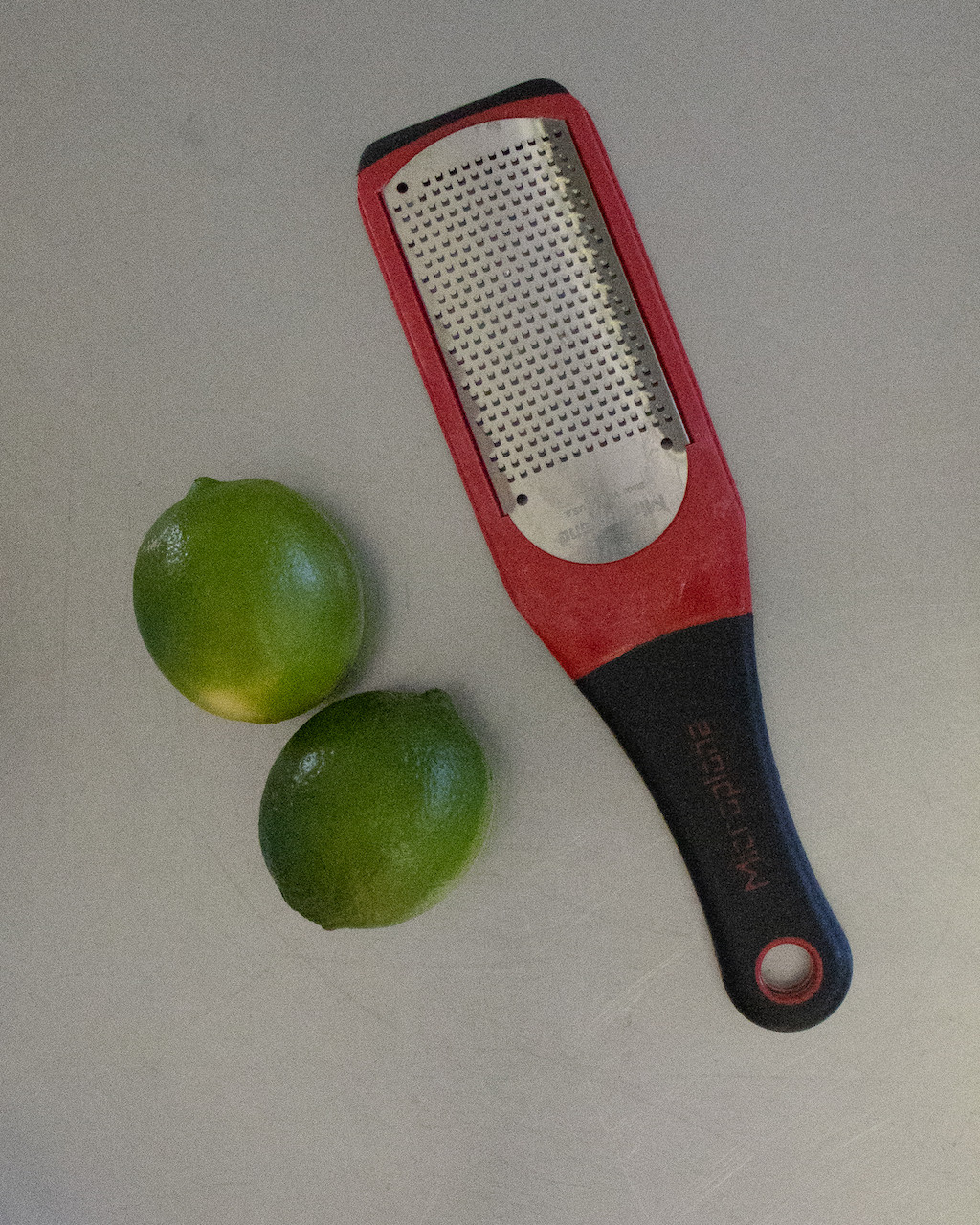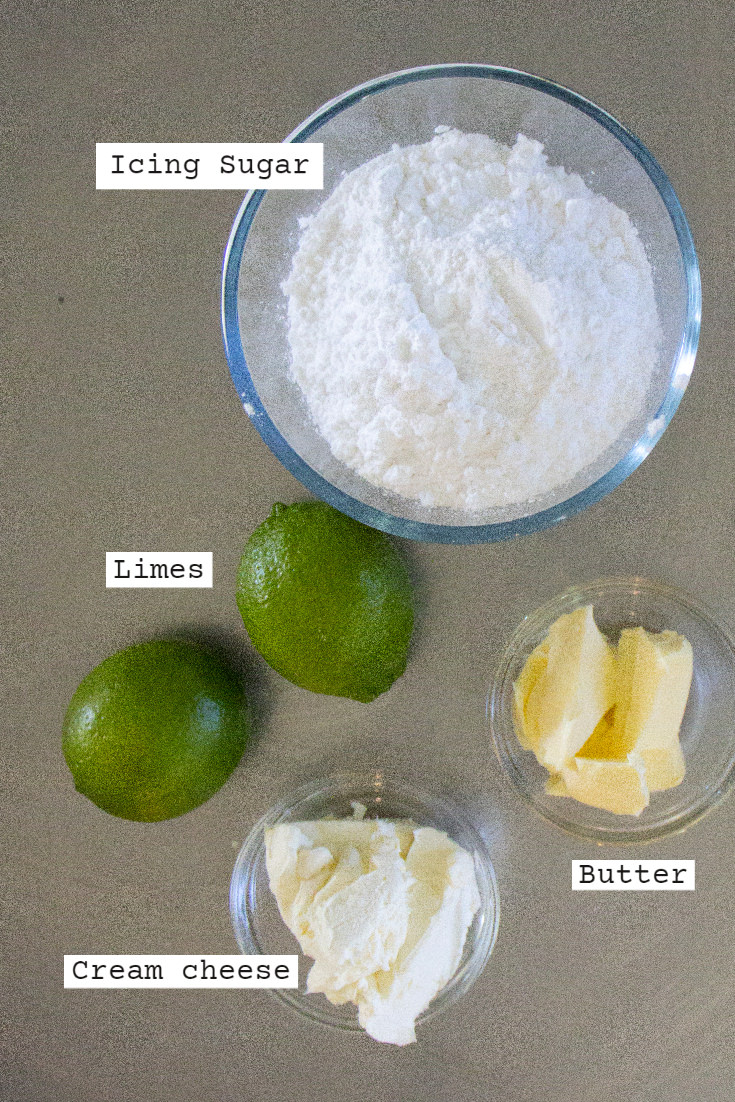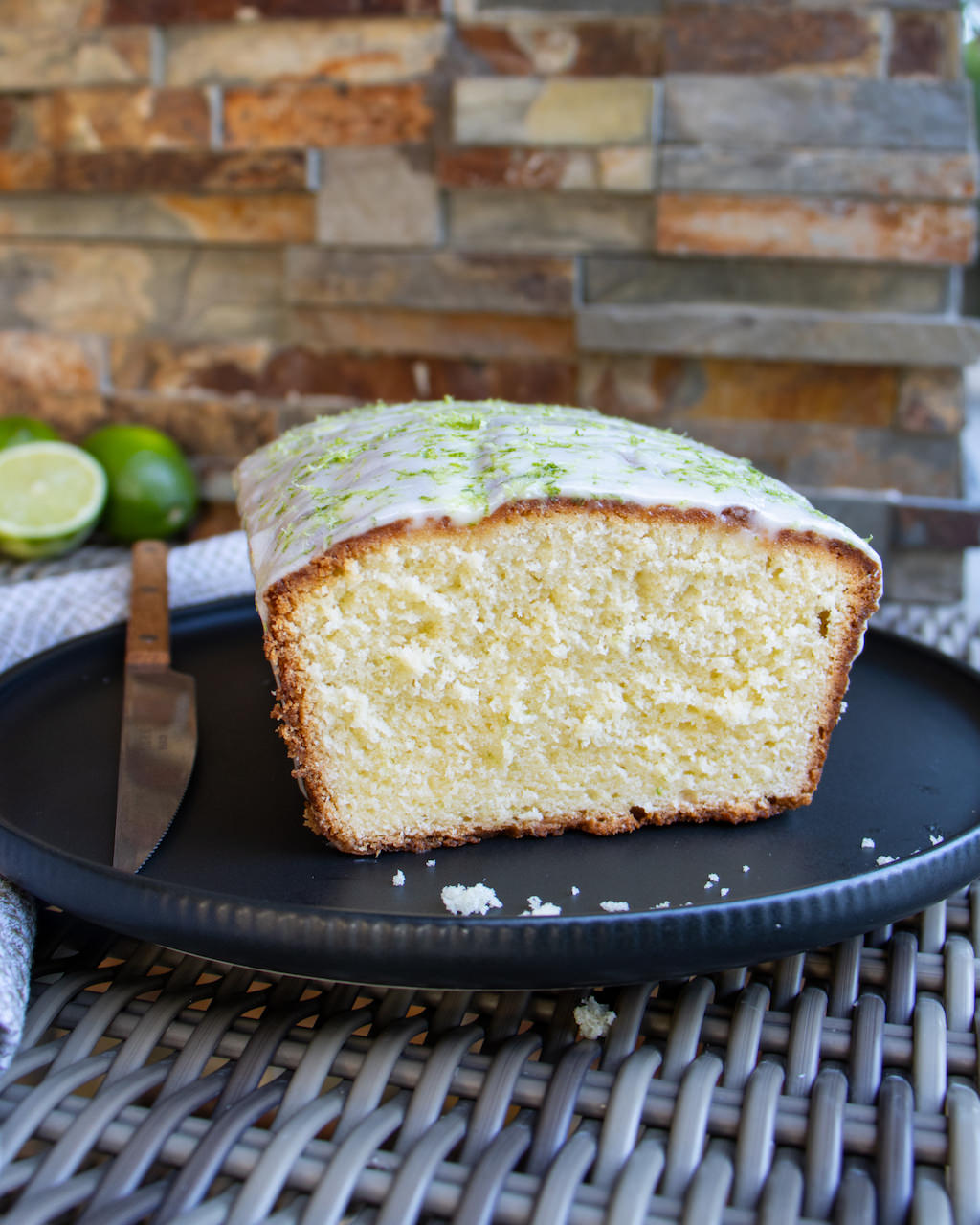I know lime cream cheese pound cake sounds so American but I can’t say it follows any traditional Aussie madeira cake recipe, so I’m calling it a pound cake.
Most Australians are more familiar with a madeira cake than a pound cake. Both are yellow sponge cakes with a dense crumb, and usually baked in a loaf pan. Advocates for both types of cake publish recipes with and without baking powder.
I think we eat ‘madeira’ cake in Australia, as this is a name that hails from the UK. The pound cake is actually considered to originate from Europe but is certainly associated with the USA in modern times.
Whether madeira or pound cake it has a pretty dense texture but the cream cheese keeps the crumb moist. It will live happily in the fridge for a week and, honestly, I think it tastes better with age.
Video

Preheat oven 175°C (155°C fan forced) with the rack in the centre of the oven. Butter and flour the loaf tin and line with baking paper (I clip the baking paper with bulldog clips). Break the eggs into a small jug.

Zest and juice the limes.
Sift the flour, baking powder and salt into a bowl & set aside.
In the bowl of a stand mixer (paddle attachment) add the sugar and lime zest, beat on medium for 1 to 2 minutes. Add the butter and cream cheese and beat on medium for 3 minutes. Scrape down the bowl.
Add eggs one at a time, beating on medium after each addition until incorporated, and then beat for 2 to 3 minutes. Scrape down the bowl.
Add the dry ingredients on low, alternating with the lime juice, and begin and end with the flour mix. Mix until just incorporated each time, you don’t want to overmix at this stage. Scrape down the bowl twice, including at the end. Beat for a maximum of 15 to 30 seconds on medium to ensure the batter is combined.
Scrape into the prepared pan, level the top with a spatula, and tap the pan on the bench top a couple times to settle the batter & remove any air pockets.
Bake in the centre of the oven at 175°C (155°C fan forced) for 50 to 60 minutes. Check after about 40 minutes.
While the cake is baking make the glaze.

Weigh the icing sugar into the sieve over a bowl. Sift the icing sugar.
In the bowl of a stand mixer (paddle attachment) add the cream cheese and butter. Note: This is a pretty small amount for a stand mixer, so you may want to use an electric hand mixer and a medium sized bowl instead. Beat the cream cheese & butter on medium 2 to 3 minutes.
With the mixer on low, add the icing sugar gradually, beating after each addition. Scrape down the bowl as required. Add the lime juice and beat. The glaze will be quite thick.

See ‘testing for doneness’ in the notes below. Remove cake from oven and transfer to a cooling rack. Use a skewer to poke holes in the cake every couple centimetres.
Let the cake sit for 15 minutes. Gently turn the cake out of the pan and then flip it upright onto the cooling rack or on a serving plate.
Before pouring the glaze over the warm cake, heat the glaze in the microwave on high 10 seconds at a time, beating with a whisk/fork each time until the glaze can pour in a steady stream. If it cools down and thickens, it can be reheated again in the microwave.
Slowly pour the glaze over the cake and down the sides. Sprinkle the zest over the cake before the glaze sets.


Lime Cream Cheese Pound Cake
Equipment
- 1 24cm x 13cm x 7cm loaf pan
- 1 peice of baking paper
- 1 kitchen scale
- 1 standmixer or electric mixer
- 1 fine sieve
- 1 microplane/ zester
- 1 set of measuring spoons
- mixing bowls
- 1 rubber spatula
- 1 metal skewer
- 1 cake tester (or use the skewer)
- 1 cooling rack
Ingredients
Cake ingredients:
- 300 grams granulated white sugar
- 2 tablespoons lime zest (2 large limes)
- 115 g cream cheese (full fat)
- 225 g unsalted butter
- 240 g all-purpose flour
- 1/2 teaspoon table salt
- 1 1/2 teaspoons baking powder (7g)
- 4 large eggs
- 1 tablespoon lime juice (20ml)
Glaze ingredients:
- 60 g cream cheese (full fat)
- 30 g unsalted butter
- 115 g pure icing sugar
- 1 1/2 tablespoons lime juice (30ml)
- 1 tablespoon lime zest (1 large lime)
Instructions
Cake instructions:
- Preheat oven 175°C (155°C fan forced) with the rack in the centre of the oven.
- Butter and flour the loaf tin andline with baking paper (I clip the baking paper with bulldog clips).
- Break the eggs into a small jug.
- Zest and juice the limes.
- Sift the flour, baking powder and salt into a bowl and set aside.
- In the bowl of a stand mixer (paddle attachment) add the sugar and lime zest, beat on medium for 1 to 2 minutes.
- Add the butter & cream cheese and beat on medium for 3 minutes. Scrape down the bowl.
- Add eggs one at a time, beating on medium after each addition until incorporated, and then beat for 2 to 3 minutes. Scrape down the bowl.
- Add the dry ingredients on low, alternating with the lime juice, and begin and end with the flour mix. Mix until just incorporated each time, you don’t want to over mix at this stage. Scrape down the bowl twice, including at the end.
- Beat for a maximum of 15 to 30 seconds on medium to ensure the batter is combined.
- Scrape into the prepared pan, level the top with a spatula, and tap the pan on the bench top a couple times to settle the batter and remove any air pockets.
- Bake in the centre of the oven at 175°C (155°C fan forced) for 50 to 60 minutes. Check after about 40 minutes.
- While the cake is baking make the glaze.
- Remove from oven and transfer to a cooling rack. Use the skewer to poke holes in the cake every couple centimetres. Warm the glaze up in the microwave and pour half the glaze over the cake slowly to allow it to get into the holes you have created. Let the cake sit for 15 minutes.
- Gently turn the cake out of the pan and then flip it upright onto the cooling rack or on a serving plate. Warm the glaze up in the microwave again if it has thickened. Slowly pour the rest of the glaze over the cake and down the sides.
- Sprinkle the zest over the cake before the glaze sets.
Glaze instructions:
Note: This is a pretty small amount for a stand mixer, so you may want to use an electric hand mixer and a medium sized bowl instead. Beat the cream cheese and butter on medium 2 to 3 minutes.
- Weigh the icing sugar into the sieve over a bowl. Sift the icing sugar.
- In the bowl of a stand mixer (paddle attachment) add the cream cheese and butter.
- With the mixer on low, add the icing sugar gradually, beating after each addition. Scrape down the bowl as required.
- Add the lime juice and beat. The glaze will be quite thick.
- Before pouring over the warm cake, heat the glaze in the microwave on high 10 second sat a time, beating with a whisk/fork each time until the glaze can pour in a steady stream. If it cools down and thickens, it can be reheated again in the microwave.
- See Cake Instructions for how to use the glaze.


I usually bake chocolate or caramel flavours, so this citrus was out of my comfort zone.
These ingredients are usually found in my kitchen anyway, so last minute it was the choice to serve with our Sunday lamb roast.
End result was delicious, and the family devoured it.
Next time I need to remember to prepare the glaze in a microwavable bowl for reheating.
I love a good citrus cake and this recipe was a delight to follow, particularly for a messy baker like me. I must say the organisation of the method and the additional notes were very helpful and I could not have been happier with the result. Everyone who had a piece loved it! We had the leftovers the next day as a treat, just slightly reheated in the microwave with a dollop of cream. Highly recommended!